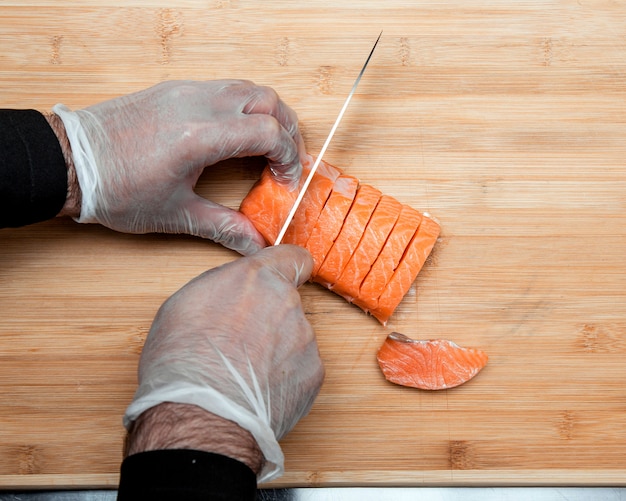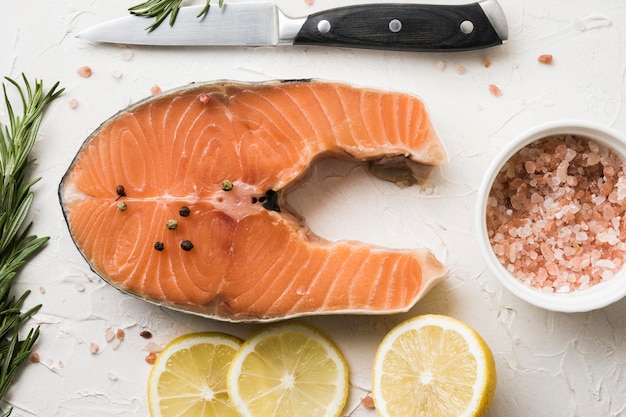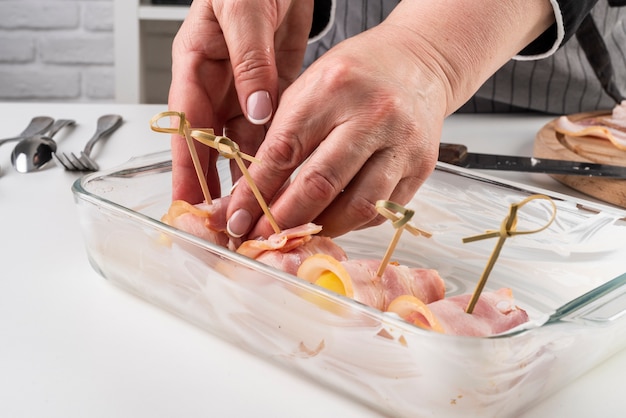Let's be honest, frozen salmon is a kitchen hero. It's there for you when you're absolutely shattered after work and haven't even contemplated dinner. And let's be clear, I'm not talking about those bland, rubbery fish fingers (though, they have their place). I'm talking about juicy, flavour-packed salmon that's practically indistinguishable from fresh – maybe even better!
I've been a frozen salmon enthusiast for years, and I've picked up a few tricks along the way. That's why I'm here to share my secrets with you – a complete deep dive into the world of frozen salmon, covering everything from defrosting to some of my favourite recipes.
Grab a cuppa, settle in, and let's get cooking!
(Part 1) defrosting frozen salmon: The Key to Success

First things first, you need to defrost that frozen salmon. It's not rocket science, but there are a few methods, each with its own advantages and considerations.
1. The Fridge Method: Slow and Steady Wins the Race
This is my personal favourite, the tried-and-true method. It's the most reliable way to ensure your salmon defrosts evenly and doesn't get soggy. Simply pop the salmon into a container or wrap it in cling film, and then stick it in the fridge for about 12 hours. This gives it ample time to thaw out completely.
2. Cold Water Method: For When You Need it Now
If you're short on time, the cold water method is a lifesaver. Just place the sealed salmon in a bowl filled with cold water. It'll defrost in about 30 minutes to an hour, depending on the size of the salmon. However, be careful not to leave it submerged for too long, as it can make the salmon watery.
3. The Microwave Method: A Last Resort
This one is a bit of a gamble. If you're truly desperate, you can use the defrost setting on your microwave. But tread carefully! It can easily overcook the salmon if you're not paying attention. It's best to check it frequently and rotate it to ensure even defrosting.
Important Defrosting Considerations
Here are some key points to keep in mind:
Never Defrost at Room Temperature: This can encourage bacteria growth, making it unsafe to eat.
Don't Refreeze Thawed Salmon: Once it's thawed, it needs to be cooked. If you refreeze it, it will affect the texture and flavour.
Be Mindful of the Packaging: Some frozen salmon comes in vacuum-sealed packaging. You'll need to remove it from the packaging before defrosting.
(Part 2) cooking frozen salmon: From Classic to Creative

Now that we've tackled defrosting, let's get cooking! Frozen salmon is incredibly versatile and can be prepared in a variety of ways.
1. Baking: The Easy and Reliable Choice
Baking is a classic method for cooking frozen salmon. It's straightforward, hands-off, and produces moist, flavorful fish. Here's how:
Preheat your oven to 375°F (190°C).
Line a baking sheet with parchment paper.
Pat the thawed salmon dry with paper towels.
Season generously with salt, pepper, and any other spices you like.
Bake for 15-20 minutes, or until the internal temperature reaches 145°F (63°C).
For a more robust flavour, consider adding a drizzle of olive oil, a squeeze of lemon juice, or some fresh herbs before baking.
2. Pan-Frying: For crispy skin and Delicious Results
This is my personal favourite method. It's fast, simple, and delivers those delightful crispy skin results. Here's the breakdown:
Heat a skillet over medium-high heat.
Add a tablespoon of oil to the skillet.
Pat the salmon dry with paper towels.
Season with salt, pepper, and any spices you desire.
Carefully place the salmon in the skillet, skin-side down.
Cook for 3-4 minutes per side, or until the salmon is cooked through and the skin is crispy.
3. Grilling: For that Smoky Flavour
If you're blessed with a grill, frozen salmon is an excellent choice. It imparts a lovely smoky flavour. Here's how to grill your frozen salmon:
Preheat your grill to medium heat.
Pat the salmon dry with paper towels.
Season generously with salt, pepper, and any other spices you prefer.
Place the salmon on the grill and cook for 4-6 minutes per side, or until cooked through.
4. Other Cooking Methods: Explore New Possibilities
There are plenty of other ways to cook frozen salmon. Get adventurous and try these:
Poaching: Gentle and flavourful, perfect for a lighter meal.
Steaming: A healthy option that preserves the fish's nutrients.
Slow-cooking: Great for a more hands-off approach.
Air-frying: Quick and easy with satisfyingly crispy results.
tips for cooking frozen salmon: Master the Basics
Here are a few tips to elevate your frozen salmon cooking game:
Don't Overcrowd the Pan: Make sure to leave enough space between the salmon fillets for even cooking.
Flip Only Once: Avoid flipping the salmon excessively, as it can break apart.
Use a meat thermometer: This is the best way to ensure the salmon is cooked to perfection.
Let it Rest: After cooking, allow the salmon to rest for a few minutes before serving. This helps the juices redistribute, resulting in a more tender and flavorful fish.
(Part 3) frozen salmon recipes: Flavour Explosions

You're ready to cook up a storm with your frozen salmon, but what to make? Here are some of my favourite recipes that are easy, tasty, and perfect for a weeknight meal.
1. honey-glazed salmon: Sweet and Savoury Perfection
This recipe is a delightful blend of sweet and savoury. You'll need:
1 lb frozen salmon fillets
1/4 cup honey
2 tablespoons soy sauce
1 tablespoon rice vinegar
1 teaspoon sesame oil
1 tablespoon grated ginger
1 clove garlic, minced
Instructions
1. Preheat the oven to 375°F (190°C).
2. Line a baking sheet with parchment paper.
3. Place the thawed salmon fillets on the baking sheet.
4. In a small bowl, whisk together the honey, soy sauce, rice vinegar, sesame oil, ginger, and garlic.
5. Pour the glaze over the salmon, ensuring it's evenly coated.
6. Bake for 15-20 minutes, or until the salmon is cooked through.
7. Serve with a side of rice and steamed vegetables.
2. lemon-dill salmon with Roasted Vegetables: A Fresh and Light Option
This recipe is bright, light, and perfect for a summery dinner. You'll need:
1 lb frozen salmon fillets
1/4 cup lemon juice
2 tablespoons chopped fresh dill
1 tablespoon olive oil
1 teaspoon salt
1/2 teaspoon black pepper
1 pound mixed vegetables, such as broccoli, carrots, and zucchini
Instructions
1. Preheat the oven to 400°F (200°C).
2. Line a baking sheet with parchment paper.
3. In a small bowl, combine the lemon juice, dill, olive oil, salt, and pepper.
4. Add the thawed salmon fillets to the marinade and toss to coat.
5. Place the salmon on the prepared baking sheet.
6. Arrange the vegetables around the salmon.
7. Roast for 20-25 minutes, or until the salmon is cooked through and the vegetables are tender.
3. spicy mango salsa salmon: A Fusion of Flavours
This recipe is bursting with flavour and a touch of heat. You'll need:
1 lb frozen salmon fillets
1 ripe mango, diced
1/2 red onion, finely chopped
1/4 cup chopped cilantro
1 jalape??o pepper, finely chopped (deseeded if you prefer less heat)
1 tablespoon lime juice
1 teaspoon salt
1/2 teaspoon black pepper
Instructions
1. Preheat the oven to 350°F (175°C).
2. Line a baking sheet with parchment paper.
3. Place the thawed salmon fillets on the prepared baking sheet.
4. In a bowl, combine the mango, red onion, cilantro, jalape??o pepper, lime juice, salt, and pepper.
5. Spoon the salsa over the salmon.
6. Bake for 15-20 minutes, or until the salmon is cooked through.
4. Salmon with Garlic Butter: A Classic Comfort
This recipe is a timeless favourite, simple yet always a crowd-pleaser. You'll need:
1 lb frozen salmon fillets
4 tablespoons butter
2 cloves garlic, minced
1 tablespoon chopped fresh parsley
1 teaspoon salt
1/2 teaspoon black pepper
Instructions
1. Preheat the oven to 400°F (200°C).
2. Line a baking sheet with parchment paper.
3. Place the thawed salmon fillets on the baking sheet.
4. In a small saucepan, melt the butter over medium heat.
5. Add the garlic and cook for 1 minute, or until fragrant.
6. Stir in the parsley, salt, and pepper.
7. Pour the garlic butter over the salmon.
8. Bake for 15-20 minutes, or until the salmon is cooked through.
5. Salmon Tacos: A Fun and Easy Weeknight Meal
These are a fantastically simple weeknight dinner. You'll need:
1 lb frozen salmon fillets
1 tablespoon taco seasoning
12 corn tortillas
1/2 cup shredded cheddar cheese
1/4 cup chopped red onion
1/4 cup chopped cilantro
1/4 cup salsa
Instructions
1. Preheat the oven to 375°F (190°C).
2. Place the thawed salmon fillets on a baking sheet.
3. Sprinkle with taco seasoning.
4. Bake for 15-20 minutes, or until the salmon is cooked through.
5. Flake the cooked salmon and fill the tortillas.
6. Top with cheddar cheese, red onion, cilantro, and salsa.
Tips for Cooking Frozen salmon recipes: Take it to the Next Level
Here are some tips to enhance your frozen salmon recipes:
Don't Overcook the Salmon: It should be cooked through but remain moist and flaky.
Use Fresh Ingredients: Fresh herbs and spices make a significant difference in the flavour of your dish.
Get Creative with Your Toppings: Don't be afraid to experiment with different sauces, vegetables, and herbs.
(Part 4) Storing Frozen Salmon: Keeping it Fresh
You've got your frozen salmon and you're ready to cook, but what about those leftovers? Or if you only need half the package for your recipe? Let's talk about storing frozen salmon.
1. Freezing Fresh Salmon: Locking in Freshness
If you're lucky enough to have fresh salmon, you can freeze it to enjoy later. Here's how:
Wrap it Tightly: Wrap the salmon in plastic wrap or aluminium foil, making sure to remove any air pockets.
Label and Date it: This helps you keep track of how long it's been in the freezer.
Store in the Freezer: Place the wrapped salmon in a freezer-safe bag or container.
2. Storing Already Frozen Salmon: Maximizing Shelf Life
If you've bought a package of frozen salmon, it's already been frozen and should be safe to freeze for up to six months. To store it properly, follow these tips:
Keep it Sealed: Ensure the packaging is tightly sealed to prevent freezer burn.
Store in the Coldest Part of the Freezer: This helps ensure the salmon remains frozen at the correct temperature.
Don't Refreeze Thawed Salmon: Once it's been thawed, it's best to cook it and avoid refreezing it.
(Part 5) Understanding Frozen Salmon: Delving Deeper
Let's dive a little deeper into the world of frozen salmon.
1. What is Frozen Salmon?
Frozen salmon is simply fresh salmon that has been frozen. It's a fantastic option for those who want to enjoy salmon but don't want to cook it immediately.
2. How is Frozen Salmon Made?
Frozen salmon is typically flash-frozen at sea, which helps to preserve its freshness and flavour.
3. Types of Frozen Salmon: A Variety of Options
You can find frozen salmon in a variety of forms:
Whole Salmon: This is a whole salmon that has been frozen. It's best for cooking in the oven or on the grill.
Salmon Fillets: These are individual pieces of salmon that have been cut from a whole salmon. They are ideal for pan-frying, baking, or grilling.
Salmon Steaks: These are thick slices of salmon that have been cut from a whole salmon. They are great for grilling or baking.
Salmon Cubes: These are small, bite-sized pieces of salmon that are perfect for adding to stir-fries, salads, or soups.
4. frozen salmon vs fresh salmon: Which is Right for You?
Let's face it, we've all stood at the fish counter, debating whether to splurge on fresh salmon. The truth is, both frozen and fresh salmon can be delicious.
Fresh Salmon: This is the more expensive option, but it's also the freshest. It has a more vibrant flavour and a softer texture.
Frozen Salmon: This is a more affordable option and can be just as delicious as fresh salmon, especially if it's been flash-frozen at sea. You're not sacrificing flavour, just that extra bit of super-freshness.
(Part 6) What to Look for When Buying Frozen Salmon: Choosing the Best
You're ready to head to the supermarket, but how do you pick the best frozen salmon? Here's what to look for:
Firmness: The salmon should feel firm and not mushy.
Color: The salmon should have a vibrant pink or red colour. Avoid salmon that is pale or discolored.
Packaging: The packaging should be intact and free of tears or punctures.
Date: Check the expiration date to make sure the salmon is still fresh.
Source: Look for salmon that's been flash-frozen at sea.
Is Frozen Salmon Good Value?
Frozen salmon is often a more affordable option than fresh salmon, making it a great value for your money.
(Part 7) Frozen Salmon and Your Health: A Nutritious Choice
Frozen salmon is a healthy and nutritious food choice. It's a good source of protein, omega-3 fatty acids, and vitamin D.
1. Omega-3 Fatty Acids: Fueling Your Body
Omega-3 fatty acids are essential for good health. They help to reduce inflammation, improve heart health, and support brain function.
2. Vitamin D: Essential for Bone Health
Vitamin D is crucial for bone health. It also helps to boost the immune system.
3. Other Nutrients: A Packed Nutritional Profile
Salmon is also a good source of other nutrients, including potassium, selenium, and niacin.
(Part 8) Frozen Salmon: Beyond the Basics
We've covered the essentials, but there's always more to learn!
1. Frozen Salmon in Recipes: A Culinary Canvas
Frozen salmon is a versatile ingredient and can be used in a wide range of recipes. Here are some ideas to get you started:
Salmon Chowder: This is a creamy and comforting soup that's perfect for a cold day.
Salmon Salad: This is a light and refreshing salad that's perfect for a summer lunch.
Salmon Pasta: This is a quick and easy pasta dish that's perfect for a weeknight meal.
Salmon Burgers: These are a healthy and delicious alternative to beef burgers.
2. Frozen Salmon for the Budget-Conscious: Affordable Delights
Frozen salmon can be a budget-friendly way to enjoy this healthy and delicious fish.
3. Frozen Salmon for a Quick Meal: Time-Saving Solutions
Frozen salmon can be a lifesaver when you're short on time. It cooks quickly and can be paired with a variety of sides.
(Part 9) FAQs: Your Burning Questions Answered
1. How long does frozen salmon last in the freezer?
Frozen salmon can last in the freezer for up to six months. It's a good idea to label the package with the date so you can track how long it's been in the freezer.
2. Is frozen salmon safe to eat?
Yes, frozen salmon is safe to eat as long as it's been stored properly and cooked to the right temperature.
3. Can I cook frozen salmon without defrosting it?
You can cook frozen salmon without defrosting it, but it will take longer and the cooking time may vary. It's best to check the packaging for cooking instructions.
4. How can I tell if frozen salmon is spoiled?
Spoiled frozen salmon will have an off-putting odor and a mushy texture. If you're unsure, it's best to err on the side of caution and throw it away.
5. What are some creative ways to use frozen salmon?
Frozen salmon can be used in a variety of creative ways. Here are a few ideas:
Salmon Sushi: Make your own salmon sushi rolls at home.
Salmon Pizza: Top your pizza with smoked salmon and cream cheese.
Salmon Tacos: Fill your tacos with flaked salmon and your favorite toppings.
Salmon Dip: Combine flaked salmon with cream cheese, chives, and lemon juice for a delicious dip.
Salmon Cakes: Combine flaked salmon with breadcrumbs, egg, and seasonings to make flavorful salmon cakes.
There you have it, a complete guide to cooking with frozen salmon. Now go forth and make some delicious meals! Remember, frozen salmon is a convenient, versatile, and healthy ingredient that can be enjoyed in many ways. Just use your imagination and don't be afraid to experiment!
Everyone is watching

Prime Rib Roast Cooking Time Chart: Per Pound Guide
Cooking TipsPrime rib roast. Just the name conjures images of lavish dinners, crackling fires, and hearty laughter. It’s ...

How Long to Bake Potatoes in the Oven (Perfect Every Time)
Cooking TipsBaked potatoes are a staple in my kitchen. They're incredibly versatile, delicious, and surprisingly easy to m...

Perfect Rice Every Time: The Ultimate Guide to Cooking Rice
Cooking TipsAs a self-proclaimed foodie, I've always been a bit obsessed with rice. It's the foundation of countless cuisi...

The Ultimate Guide to Cooking Asparagus: Tips, Techniques, and Recipes
Cooking TipsAsparagus. The mere mention of this spring delicacy conjures up images of vibrant green spears, crisp and burs...

Ultimate Guide to Cooking the Perfect Thanksgiving Turkey
Cooking TipsThanksgiving. Just the word conjures up images of overflowing tables laden with delicious food, the scent of r...
